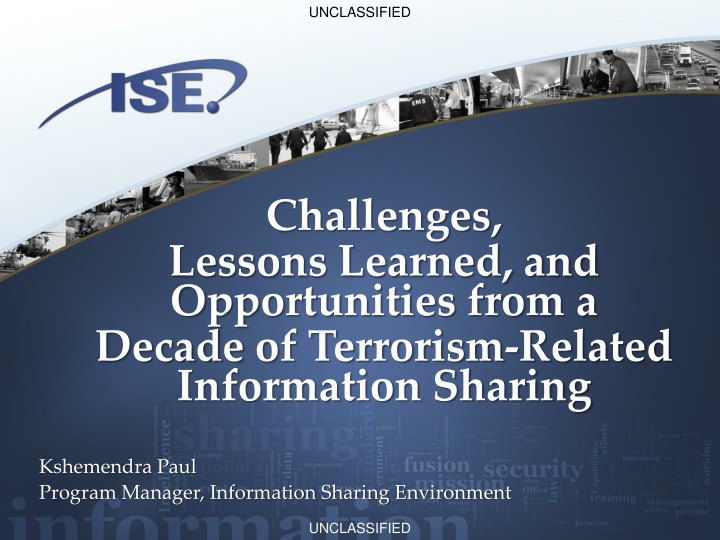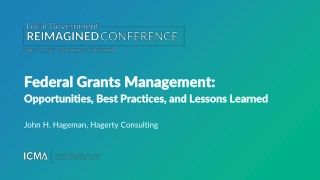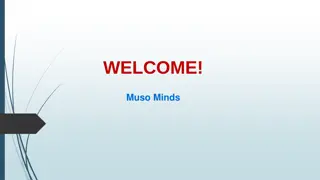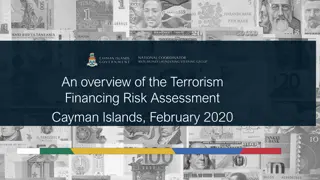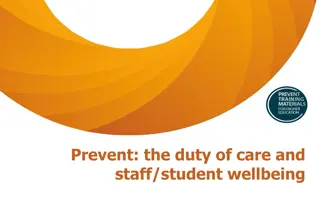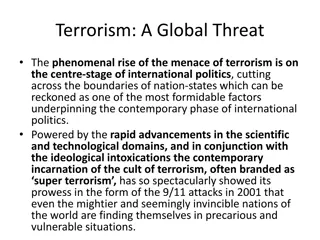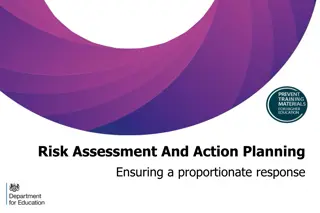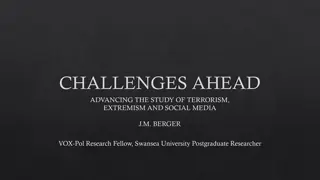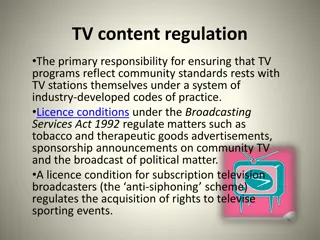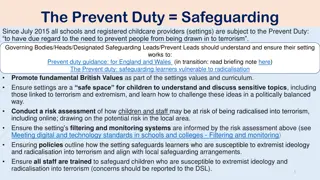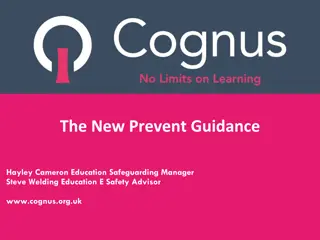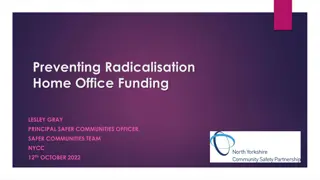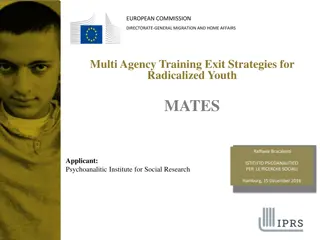Challenges, Lessons Learned, and Opportunities from a Decade of Terrorism-Related Information Sharing
This document explores the challenges, lessons learned, and opportunities in terrorism-related information sharing over a decade. It covers topics like network-centricity, collaboration imperative, safeguarding data, and nationwide interoperability. The content delves into the scope of the Information Sharing Environment (ISE), success factors, frameworks, and the current state of related projects. It outlines nationwide challenges, key stakeholders, and the importance of cohesive policies for effective information sharing among various entities involved in national security.
Download Presentation

Please find below an Image/Link to download the presentation.
The content on the website is provided AS IS for your information and personal use only. It may not be sold, licensed, or shared on other websites without obtaining consent from the author.If you encounter any issues during the download, it is possible that the publisher has removed the file from their server.
You are allowed to download the files provided on this website for personal or commercial use, subject to the condition that they are used lawfully. All files are the property of their respective owners.
The content on the website is provided AS IS for your information and personal use only. It may not be sold, licensed, or shared on other websites without obtaining consent from the author.
E N D
Presentation Transcript
UNCLASSIFIED Challenges, Lessons Learned, and Opportunities from a Decade of Terrorism-Related Information Sharing Kshemendra Paul Program Manager, Information Sharing Environment UNCLASSIFIED
AGENDA My Journey Bottom Line Up Front (BLUF) Nationwide Challenges ISE Scope & Governance Nationwide Successes Big Idea: Terrorism-related Information Interoperability Big Idea: Information Sharing & Safeguarding Core Interoperability Framework Current State of ISE Project Interoperability & Playbook Standards Coordinating Council How to Leverage our Work for Your Benefit 2
BRITISH MUSEUM, MARCH 2013 3
BLUF Challenges Network-centricity, or going horizontal in a vertical world Culture & boundaries as impediments to collaboration & info sharing Immature frameworks, architectures, standards Lessons Learned Multi-disciplinary, open, iterative approach w/ terrorism-related focus drove progress Bottom-up, persistent pressure can transform government Pooling authorities and coordinating based on common requirements Opportunities Distributed & decentralized yet coordinated government operations ISE is a successful model for networked, virtualized, open government Dual (Multi) use capabilities; mission agnostic frameworks 4
NATIONWIDE CHALLENGES Evolving & Converging Threats & Risks Collaboration Imperative Strengthening Safeguarding Enterprise Data Management National Approaches to Interoperability Common Operating Models Consistent, Transparent & Federated Policies Interoperable Capabilities & Shared Services 300+ million People 78Fusion Centers 28 HIDTAs FBI 18,000 LE Agencies NCIJTF CJIS FIGs JTTFs JRIGs TSC 750,000+ Officers DoD 6 RISS Centers Nlets Air Domain 250,000 911 Operators 1.2 million Firefighters DHS I&A ICE CBP TSA DNDO NPPD State 2.2 million Security Officers Maritime Domain DOJ ATF DEA USMS OJP 18CI/KR Sectors NCTC JCAT * Numbers are estimates Protection of Privacy, Civil Rights, and Civil Liberties 5
ISE SCOPE International Private Sector Tribal Local State Federal Law Enforcement Communities Information Sharing Environment (ISE) Defense Frontline Investigators Analysts Operators Intelligence Homeland Security Diplomacy Information Technology Industry 6
NATIONWIDE SUCCESSES Frameworks and Standards for Responsible Information Sharing Institutionalized ISE Enterprise Architecture Framework via Project Interoperability International standards alignment and ICT Industry involvement via the Standards Coordinating Council Recognized leadership with assured information interoperability Simplified sign-on, no wrong door approach touching over 500K registered FSLTTPS end users Basis for government-wide domain awareness initiatives including but not limited to Maritime Terrorism-Related Collaboration in Domestic Nexus of National Security & Public Safety Mature National Network of Fusion Centers the domestic information and intelligence sharing platform Alignment between and among field-based intelligence and information sharing entities Suspicious activity reporting; deconfliction; request for information; alerts, warnings, notifications Scaling to public safety federated ICAM with FirstNet and Next Gen 911 Policy, Governance, Performance, & Planning Reasonable implementation and ongoing evolution of capabilities of 2007 NSIS and 2012 NSISS Privacy polices in-place, implemented, audited, and improved across ISE stakeholders Support to USG D/As to mature capabilities and address GAO, IG, and other findings Integration of non-federal stakeholders into ISE processes and procedures Stakeholder Engagement, Advocacy, Workforce, & Culture Change Premier advocate for responsible information including dissemination of knowledge and best practices Processes for identifying requirements and gaps, and working with partners Training materials targeting and delivered to policy, mission management, and frontline personnel Supporting stakeholders, individually and as organizations, to embrace responsible information sharing 8
TERRORISM-RELATED INFORMATION INTEROPERABILITY Counter Terrorism Dual Use Capabilities Network Centric Mission Agnostic Resources Data Access & Discovery 9
IS&S CORE INTEROPERABILITY FRAMEWORK (ICIF) VISION SBU National Defense Tip-off ISE Fusion Center 1 SP Intel Analyst ISE ISE ISE Member Member Federal Sharing State/ Regional ISE Intelligence Community Fusion Center 2 ISE ISE Member Industrial Base Critical Infrastructure Inter Federation Geospatial COI COI Mission Interest Tactical Narcotics Takedown Project Cyber Defense COI Project Money-laundering Investigation Deconfliction 10
STATE SUMMIT 11
CURRENT STATEOF ISE 15 States engaged in ISE implementation State Summit Federal agencies have adopted some ISE components Mission focused ISE development (NJ Opioid ISE) New assertion based architecture (ICIF under development) Project Interoperability 2.0 being constructed NGA Follow-up Ten Priorities for Action 12
PROJECT INTEROPERABILITY An integrated set of mission- agnostic documentation and technical resources that: Facilitate operational integration of the ICIF Advocate standards & technologies most likely to achieve compatibility, performance, and scalability desired in an ISE Bootstrap ISE owners in building, growing, and optimizing their ISEs Models Standards ICIF Templates Training Reference Architectures Guidance 13
PROJECT INTEROPERABILITY COMPONENTS USERS SAVE TIME AND MONEY in aligning their architectures and establishing ISEs; barriers to entry fall Project Interoperability 2.0 ISE Core Interoperability Framework (ICIF) ISE Integration Library REDUCES IMPLEMENTATION RISK by making available interoperability examples, a common vocabulary, etc. Outreach and Engagement ISE Supporting Standards Technical Assistance SCALING TRUST by moving to federated, standard, and automated enforcement of policy assertions at both the technical and policy levels in an ever- changing ecosystem 14
PROJECT INTEROPERABILITY RESOURCES (FY16-18) Marketing & Outreach Resources ISE Value Proposition Executive Guide to Info Sharing ISE Integration Resource Library ISE Technical Assistance and Training Directory ISE SCC Website (CT & I/O) CONOPS Executive Training Website Scenarios & Use Cases ICIF Implementation Guidance (Planner s Guide) Implementer & Assessor Training Architecture Alignment Guidelines Technical Assistance Resources IS&S Playbook Cyber I/O Roadmap UML Profile Templates Assertion Framework Technical Spec Assertion Authoring and Publishing Capability Assertion-Based Agreement Capability Assertion Assessor Capability Assertion Operational Infrastructure ICIF Assertion Framework ICIF Standards, Guidelines, Assertion Definitions Security TDs and TIPs Privacy TDs and TIPs Threat and Risk Model Domain Reference Models (DARA, GIRA, etc.) RESTful ICAM TDs and TIPs I2F & CPF Assertions ISE TIPs UML Model Standard Lexicon Policy, Governance and Operational Procedures ICIF ICIF Capability Model ICIF Policies & Procedures ISE Policy Governance Overview To Be Developed Complete & Approved Under Development 15
IS&S PLAYBOOK Play 1 Understand what people need Play 2 Gather the stakeholders Play 3 Develop the concept of operations Play 4 Identify and get support from critical sponsors Play 5 Identify existing capabilities and gaps Play 6 Identify and select relevant standards Play 7 Create a data management policy Play 8 Assemble the implementation team Play 9 Acquire needed resources Play 10 Manage implementation Play 11 Automate testing and demonstrate success Play 12 Deploy the IS&S environment Play 13 Measure and report the impact Play 14 Share your experiences Play 15 Maximize responsible data transparency Play 16 Make it scalable and sustainable 16
ALIGNING KNOWLEDGE RESOURCES IS&S Mission Communities Project Interoperability 2.0 Models Standards ICIF Templates Training ICIF Concept BoK Executives, Reference Architectures Guidance Mid-level Managers, and Implementers ISE Knowledge Management 17
STANDARDS COORDINATING COUNCIL www.standardscoordination.org 18
HOWTO LEVERAGE OUR EFFORTS Visit the SCC and ISE websites Use the IS&S Playbook and referenced resources Engage via existing membership with SCC members Explore your association or organization joining the SCC Join an SCC working group standardscoordination.org ise.gov 19
VISIT ISE.GOV @shareandprotect 20
